how to find resting heart rate
Resting Heart Rate and Heart Rate Variability (HRV): What's the Difference? — Part 2
The Technology
![]()
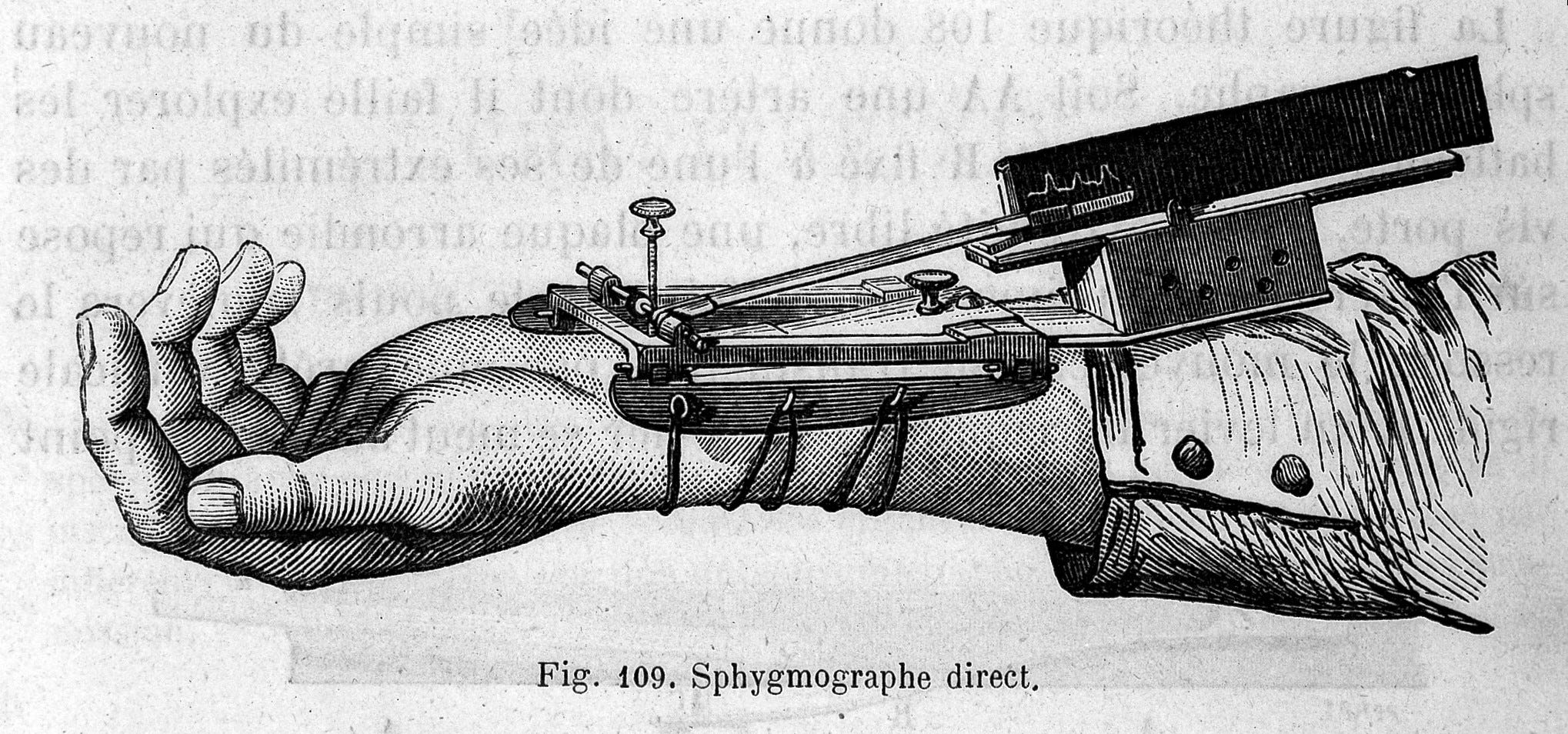
In part 1, I covered the basic physiology of heart rhythm regulation. This second part is all about technology. In particular, I will cover how technology for heart rate and HRV analysis works, the main limitations of different approaches, and some important misconceptions.
The goal of this post is not to pick a tool, but to help you make informed decisions in a fast-evolving field. At the end of the blog it should be clearer why some sensors can be trusted, and why others can be used just for resting heart rate, and not for HRV.
In t h e next parts of this guide, we will finally look at the data and see how we can gain different insights from both heart rate and HRV, how they can at times capture the same processes, and how they can at times greatly differ (and why!).
You can find the other parts of this series at these links:
- Part 1: The Physiology
- Part 2: The Technology (this post!)
- Part 3: Population-level data
- Part 4: Individual-level data
- Part 5: Takeaways
Check out my Twitter (@altini_marco) for updates.
Common technologies for resting heart rate and HRV measurement
Resting heart rate has been measured for more than 2000 years already, without the need of any technology. However, as I have discussed in part 1, HRV analysis requires the exact timing of beat-to-beat differences, which is something that does require (accurate) technology. In this context, most of what we know is due to research carried out in the past 50–60 years, since portable electrocardiograms (ECGs) were developed.
Note that when you use a sensor to measure HRV, you get also heart rate for free. The same technologies can be used to measure heart rate and HRV, and typically these can be grouped into three categories:
- Electrocardiography (ECG)
- Plethysmography (PPG)
- Ballistocardiography (BCG)
Intuitively, the three measures are tightly coupled. As the heart contracts, blood is pushed via your arteries, and this flow of blood can be measured in different ways. PPG signals can be acquired with sensors designed specifically for the purpose of HRV analysis, typically by means of an infrared LED and receptor, or simply by using a phone camera and flash. The first method relies on light absorption, the second on reflection. This is the principle used by some mobile phones apps or video-based systems relying on PPG, such as the HRV4Training app.
As measurement locations, any area with arteries close to the skin, such as the finger or earlobe, is preferable. The wrist tends to provide more noisy data, but can be used reliably at rest.
Let's look at how each of these works, and what are the pros and cons.
Electrocardiography
ECGs measure the electrical activity of the heart. The very first electrocardiogram (ECG) machine was developed by Willem Einthoven, at the University of Leiden at the beginning of the 20th century. The principle behind an ECG machine's functionality is pretty simple. During each heartbeat, the heart depolarizes and repolarizes. This process, which is what characterizes the heart muscle's electrophysiology, results in electrical changes on the skin which can be measured by ECG. Typically, reference systems used in studies require gel electrodes. However, other more user friendly sensors are commercially available, such as for example Polar straps. In our previous work, we have shown how both types of ECG systems provide the same results for HRV analysis.
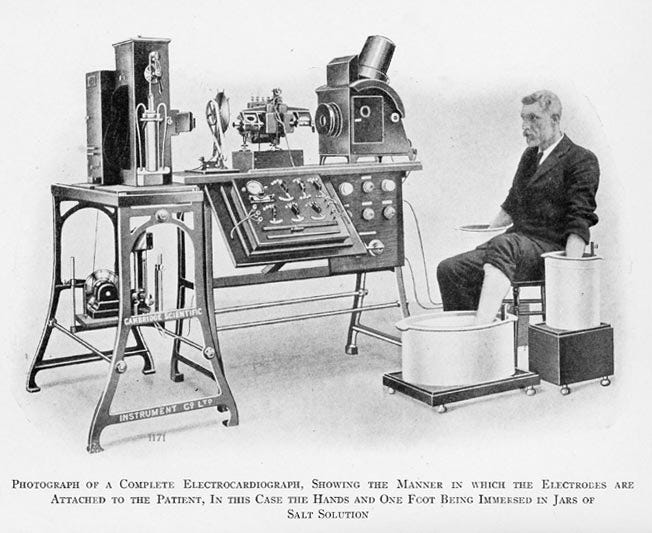
Pros:
- Typically accurate
- More robust to certain types of artifacts (e.g. movement)
Cons:
- The main limitation when it comes to chest straps is comfort. The electrodes in the strap need to be a little humid, and while this happens naturally when you train because of sweat, getting the chest strap wet early in the morning, combined with the cold feeling when you put it on, is enough of a deterrent for many. Note that not taking care of these aspects can make the data very unreliable (generating many artifacts).
- Application agnostic. The strap doesn't know you are using it for HRV analysis, and as such, will report all RR intervals, even when generated by artifacts (ectopic beats or measurement errors). The app you connect the strap to, will have to deal with artifacts correctly, to avoid the issues described below.
Plethysmography
PPG is used in optical measurements found in watches or simply using the camera of your phone. PPG consists of detecting changes in blood volume during a cardiac cycle, by illuminating the skin and measuring light absorption or reflection. It was developed in the 1930s and finally became pervasive in hospitals with more recent technological developments in the semiconductor industry, in particular in the 1970s as digitalization became widespread. Camera based apps such as HRV4Training or sensors like the Oura ring or Whoop rely on this technology.
Pros:
- User comfort and convenience are certainly the big advantages of PPG sensors, with respect to chest straps. Using just your phone without any external sensor, or your Apple Watch for the morning measurement, or an Oura ring during the night, makes it much easier to collect data.
- Cost: using the phone camera reduces cost, since no additional hardware or sensor is required, without sacrificing accuracy .
Cons:
- Movement disrupts the signal, and therefore data should be collected either for short periods while not moving in the morning or during the night. Night data should also identify and discard artifacts (more on this later).
- Artifact detection and removal becomes even more important due to the issues of optical measurements in case of movement.
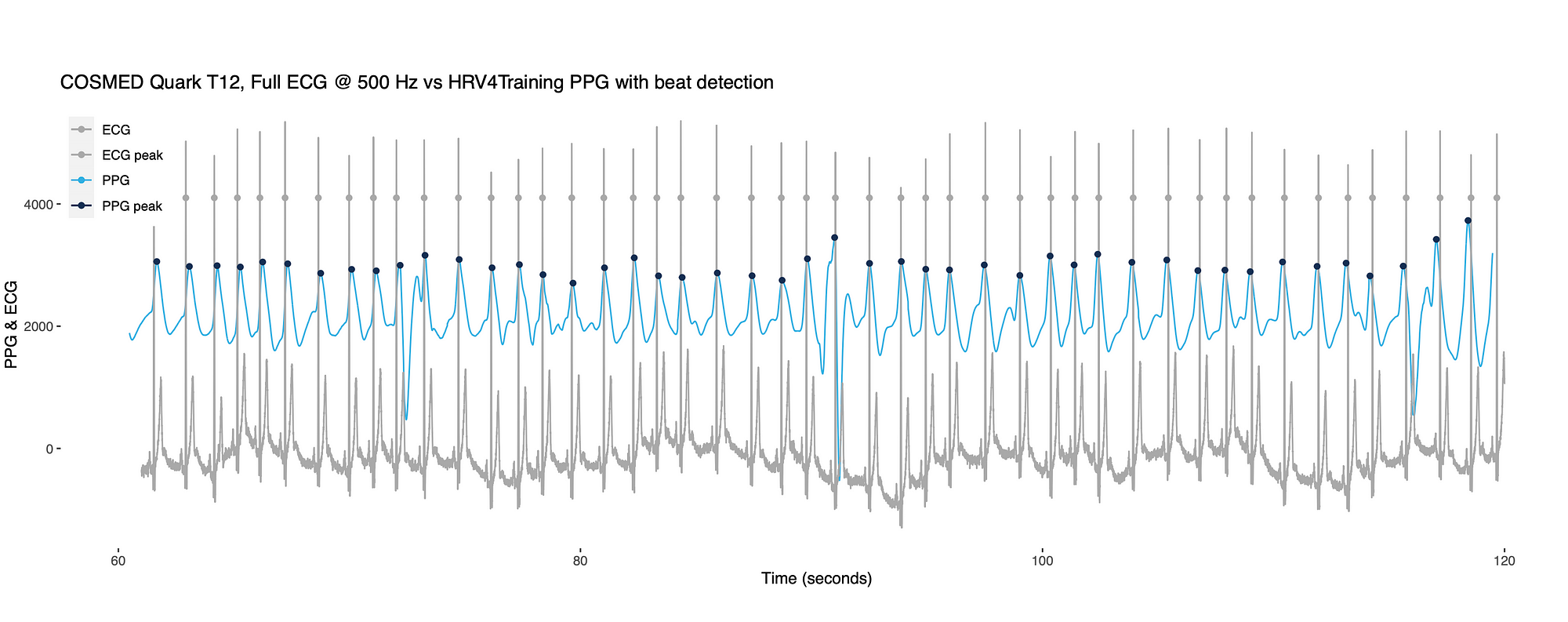
Ballistocardiography
BCG refers to sensors you place under or in your mattress. BCG measures the force caused by a person's blood moving inside the body every time the heart beats. Such blood movement causes small repetitive movements of the whole body, which can be captured by placing for example an accelerometer above or below the body. This is what you have in Eight Sleep.
Pros:
- The main advantage of BCG systems is the classic set and forget, since once you have installed the system, it will measure during the night while you sleep and you don't have to intentionally take a measurement.
Cons:
- The main limitation is that typically you don't travel with your system, and could miss important data points during more stressful days. When using a BCG system, there are also important considerations about how the data is used and reported (for example the full night or just a few minutes). I will discuss this point in detail below, as this is common also to sensors that use PPG during the night.
For all of these methods, the technology can be accurate, but the type of technology is not what defines the accuracy, the algorithms are. In the next section, I look at key must-haves related to how the technologies above acquire and process data for heart rate and HRV measurement.
Must-haves
There is a simple and key distinction to make between measuring resting heart rate and HRV, which has important implications for the technology used: heart rate is a more stable signal, and less prone to error, with respect to HRV.
What does this mean? First, that when measuring heart rate, small errors or artifacts can be fine (see below for an example). On the other hand, when measuring HRV, a single artifact (for example a misdetected beat or an ectopic beat due to an actual arrhythmia or simply a measurement error due to movement) can make the data completely unusable. Secondly, even when the data is accurate, the timing of the measurement will have a larger impact on HRV, with respect to heart rate. An accurate device used at the wrong time will produce data that is of less or even of no practical use, due to the fast-changing nature of autonomic nervous system mediated HRV.
There is absolutely no doubt that all of the technologies above can measure HRV accurately. However, this does not mean that any sensor will be able to do so, in any of the three categories (ECG, PPG or BCG). Below I cover in more detail three important must-haves:
- The sensor must be made for HRV analysis, otherwise, it might smooth the data to provide more stable heart rate readings, but artificially decrease HRV in the process.
- The algorithms used to compute HRV need to be able to handle artifacts correctly. Missing a single artifact over a 1–5 minutes segment can make HRV data unusable.
- The timing of the measurement will also matter, for interpretability, regardless of the accuracy of the measurement.
Let's look in more detail into these aspects, which are agnostic to the technology used, or in other words, no matter what sensor you use (ECG, PPG, or BCG), these are key aspects to keep in mind and check for the technology you use.
1. Made for HRV analysis
Unfortunately for most sensors out there, HRV analysis is a bit of an afterthought. Most PPG watches, for example, have been developed to measure heart rate "reliably" during exercise, as a more comfortable replacement for chest straps. Unfortunately, motion completely disrupts PPG data, making the task of reconstructing your heart rate while exercising very difficult. What does that have to do with our HRV measurements at rest? Well, the issue is that most sensor manufacturers have developed techniques to make sure they can deal with such motion artifacts, and still be able to provide you with a decent estimate of your average heart rate in the past 10–30 seconds. These techniques make the signal much more stable, but to do so, they filter it heavily and make it unusable for HRV analysis. Basically, beat-to-beat differences are artificially modified to stabilize the signal.
Let's look at an example of artificial smoothing of RR intervals. Below we have data collected from 3 sensors:
- Polar H7 (ECG based)
- HRV4Training iPhone camera (PPG based)
- Scosche rhythm+ (PPG based)
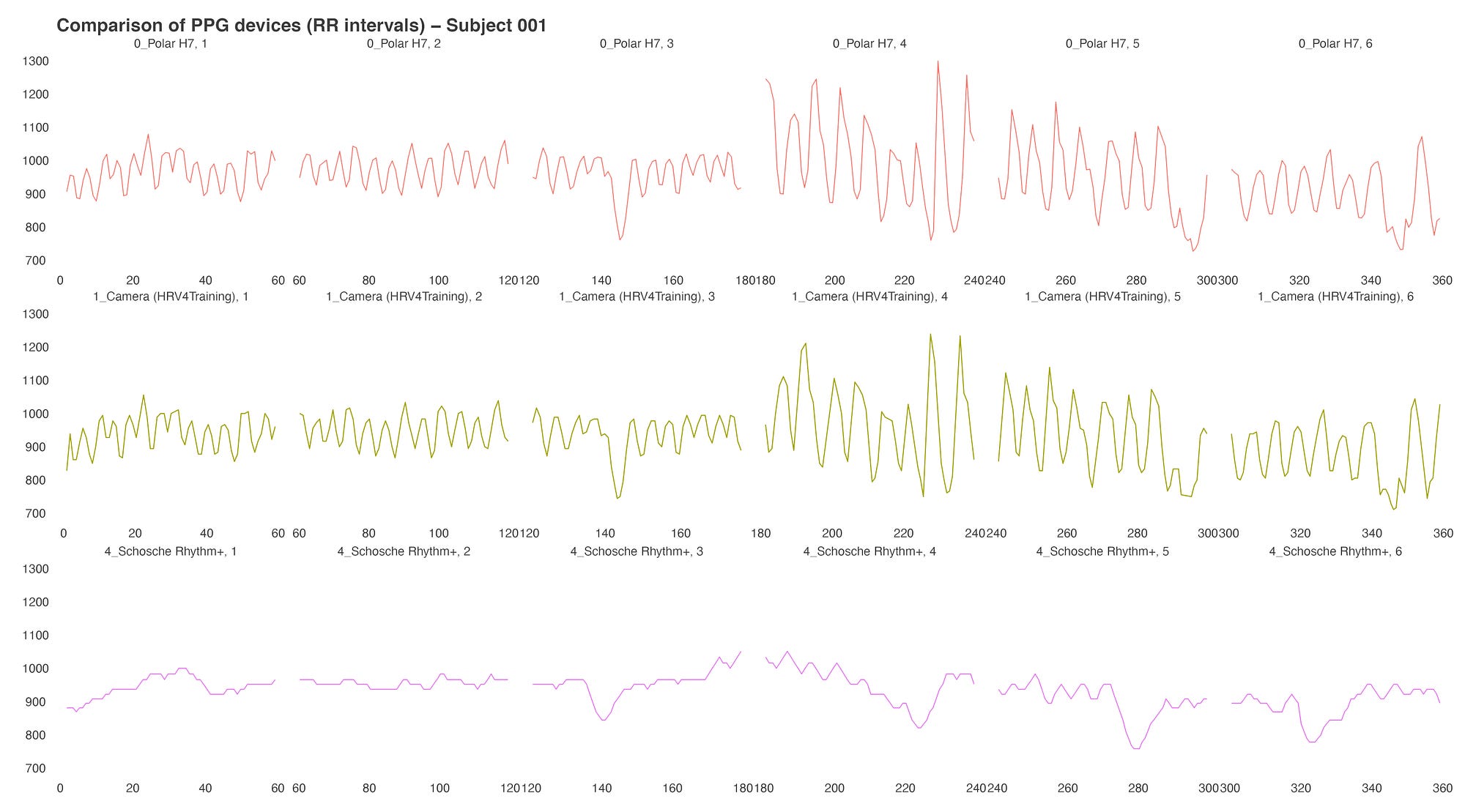
Each row represents a different sensor, each column a minute of RR interval data. In this case the Scosche rhythm+ (not to be confused with the Scosche rhythm24), in row 3, shows smoothed oscillations in RR intervals. The sensor is therefore unable to pick up beat-to-beat differences and variability (HRV), while still providing accurate heart rate. Rows 1 and 2 show reference Polar H7 data, and camera-based acquisition using HRV4Training, both capturing beat-to-beat differences with high accuracy. The measurement protocol included three minutes of relaxed breathing and two minutes of deep breathing (greater oscillations in RR intervals).
This is the typical behavior of many sensors and should highlight how an accurate measurement of resting heart rate, does not guarantee an accurate measurement of HRV. Note how the issue is not the technology per se (PPG), but how the data is processed.
Rest vs exercise
Another key point that might be counterintuitive is that a device that is inaccurate for heart rate during exercise, is not necessarily inaccurate for HRV analysis at rest, as long as 1) it uses different processing 2) it can handle artifacts properly (discussed later).
One of the major issues, when the first sensors were released, was that they would still communicate RR intervals to third-party apps, but they would communicate these smoothed RR intervals that result in incorrect HRV data, without the third-party app being aware that data was modified. As things have evolved and this problem has been made obvious, some companies developed sensors that either are to be used only at rest (e.g. the CorSense by Elite HRV), or provide different modalities, one that averages RR intervals for accurate heart rate analysis during workouts (workout mode), and one that provides accurate RR intervals for HRV analysis (HRV mode), without any smoothing. Other sensors do this switch automatically (e.g. measure HRV during the night and exercise heart rate or no data during the day).
Using different modalities is a good first step, but still prone to general difficulties associated with HRV analysis, which brings us to the next point: managing artifacts.
Bottom line:
- Make sure the sensor you use was developed for HRV analysis. Measuring resting heart rate accurately is not sufficient and requires different signal processing techniques.
- If your sensor provides both heart rate data during exercise and HRV at rest, make sure it is smart enough to understand that HRV analysis should be performed at rest, using different processing techniques. This is the case for the most common brands.
2. Managing artifacts
Earlier I mentioned how when measuring heart rate, small errors or artifacts can be fine. On the other hand, when measuring HRV, a single artifact can make the data unusable.
Let's look at one example, I will use ECG data as this considered the "gold standard" simply to make this point really clear: no matter what technology you use, the algorithms (the app you use) need to deal with artifacts, which is not something to take for granted.

Detected beats are highlighted in red above. We can see there is an ectopic beat towards the end, which clearly does not affect resting heart rate: the beat is out of place, but it is still the same number of beats in a minute, hence the same resting heart rate.
What about HRV? What happens if we don't do any post-processing and compute HRV (let's consider the usual case of computing rMSSD), for the data shown above? Well, while the rMSSD without artifacts is 79 ms, adding the ectopic beat causes a jump up to 201 ms. Obviously, parasympathetic activity has not changed, and yet we get more than 2x the HRV.
I have discussed artifact removal in more detail elsewhere, my point here is simply that managing and removing artifacts is a key aspect of the difference between resting heart rate and HRV. This is the main reason why it is important to validate new technologies. There is no doubt that you can measure accurately HRV with very different methods. However, technology companies need to show that the way they process the data is reliable, which is why no sensor should be trusted until such data has been reported.
Takeaway:
- All technologies are affected by artifacts, either due to measurement error or actual ectopic beats.
- Validations are key to prove that a given sensor can not only measure HRV accurately but also deal with artifacts. Ideally, validations should cover a very broad range of HRV values collected in realistic settings.
A note on arrhythmias
In the context of resting heart rate and HRV analysis, arrhythmias are artifacts. We just saw in the example above that a single beat out of place will cause a disruption and artificially increase HRV. Normally, when we have such isolated events, we can deal with them and provide accurate estimates of HRV. However, if the issues are more frequent, and happen every few seconds, there is nothing to do and simply HRV cannot be correctly determined. In my view, it is quite pointless to pretend that a sensor will always provide high-quality data (no matter how much you pay for it), especially when it comes to optical sensors (watches, wristbands, etc.). Motion will always be an issue, and sometimes data might need to be discarded due to arrhythmias. This is why we always report signal quality at the end of the measurement.
Unfortunately, if your arrhythmia is frequent during the night, there is no point using a device that measures as you sleep. In this case, the only way to measure HRV is to take a morning measurement during a period in which you have no or fewer ectopic beats. HRV4Training can normally deal well with a few artifacts per recording and report back in case of issues. Note that heart rate is typically reliable even with frequent ectopic beats, while other forms of arrhythmia could also disrupt heart rate. These issues should be carefully evaluated in sports settings as athletes tend to have a higher prevalence of ectopic beats, especially in the context of endurance sports.
3. Timing of the measurement
Recent developments made automated measurements more common. For example, using an Oura ring you can measure your resting heart rate and HRV during the night, without taking a morning measurement. Similarly (but with some key differences) an Apple Watch also collects a few randomly sampled data points throughout the night (or you can use it to trigger an HRV measurement using the Breathe app).
Here we are getting into more nuanced territory. Say our sensor 1) was made for HRV analysis, and can measure beat-to-beat differences accurately 2) can handle artifacts and other issues correctly. Can we trust the data?
Unfortunately, not necessarily.
Without getting too much into data analysis and interpretation, we should not forget our goal here. In these posts, our application of interest is determining chronic physiological stress level, which derives from combined strong acute stressors (e.g. a hard workout, intercontinental travel) and long-lasting chronic stressors (e.g. work-related worries, etc.). By measuring the impact of various stressors (e.g. training or lifestyle) on our resting physiology (HR and HRV), we can make meaningful adjustments that can lead to better health and performance.
In this context, morning measurements (e.g. taken with HRV4Training via the phone camera or using a chest strap) and full night measurements (e.g. using an Oura ring) are the only two well-established and reliable ways to assess your HRV. On the other hand, HR and HRV randomly sampled during the night or day, are still representative of autonomic activity but are of poor interpretability. Why?
Mainly for two reasons:
- Influence of the circadian rhythm on autonomic activity
- Influence of sleep stages on autonomic activity
The circadian rhythm affects our physiology. This means that there are changes in physiological variables such as heart rate and HRV, that depend on the time of the day (or night). If we use a data point collected at 1 am one day, and at 4 am another day, then we might have large variability between the scores simply because they are far apart. This is what happens also when we try to use data from a single sleep stage, which could be anytime during the night, due to the nature of sleep.
A recent paper (available here), highlighted what I had previously discussed, or how using just a few minutes of data collected during the night makes HRV data less reliable. Note that despite this artificially introduced variability due to suboptimal sampling, you can most likely still capture acute stressors that have a strong effect on your physiology (excessive alcohol intake or getting sick), but much of the sensitivity of HRV to more subtle stressors can be lost. These are important aspects because despite measuring during the entire night, selecting a short segment for data analysis you end up letting your data point being confounded by the time of the measurement as well as the (in)accuracy of sleep stage detection. This issue does not affect as much resting heart rate, which is once again more stable over time.
Note that when you measure first thing in the morning, you do not have any of these issues: you are awake (no sleep stage influence) and you most likely wake up at similar times each day (no circadian rhythm influence either). However, timing is still key. You need to remember to take your measurement first thing in the morning, before doing anything else, so that other stressors (e.g. having coffee or exercising) do not become confounders.
Takeaways
In the previous part of this series, we have learnt how the body at rest is predominantly parasympathetic and how both resting heart rate and HRV reflect parasympathetic activity. We have also seen how HRV is more tightly coupled to the parasympathetic system, and therefore becomes a more sensitive metric when it comes to stress responses.
In this blog we have seen how being more sensitive to changes in parasympathetic activity comes with some disadvantages, for example HRV is less stable or more volatile when not properly contextualized, as well as more prone to measurement error. These peculiarities of HRV do not necessarily apply to resting heart rate, and have important implications in terms of the technology and signal processing techniques used.
This is why it is key to use validated sensors and apps but also to use data collected at the right time. Technology is continuously evolving, and I hope this post was helpful to better understand what is possible, what are the limitations, and most importantly, to learn to ask the right questions.
To conclude:
- Heart activity can be measured in different ways, using electrodes to pick up electrical current, capturing body movement as a result of the heart pumping blood, or using light absorption or reflection to detect blood flow. All methods are potentially capable of measuring HRV correctly.
- All technologies are affected by artifacts, either due to measurement error or actual ectopic beats. Using ECG technology does not make the data better quality. On the contrary, chest straps do not do any artifact processing and the app you use becomes even more important to ensure correct HRV analysis.
- You have different options and trade-offs available in terms of sensing modality, cost, and ease of use. Chest straps, wristbands, rings and apps using the phone cameras can all be reliable, but make sure they have been developed and validated for the purpose of HRV analysis.
- Sensors that are accurate might still provide less useful data when automatically sampling during the night, especially if they report only 5 minutes of data or a few data points. Resting heart rate is less affected by this problem, as it is a more stable (less variable) signal. On the other hand, HRV is highly affected by this issue, and therefore I would highly recommend using a sensor that averages at least 4–5 hours of data during the night.
In the next posts, we'll start looking at some data, both at the population and at the individual level, to better understand how we can use resting heart rate and HRV data in the context of health and performance.
Stay tuned.
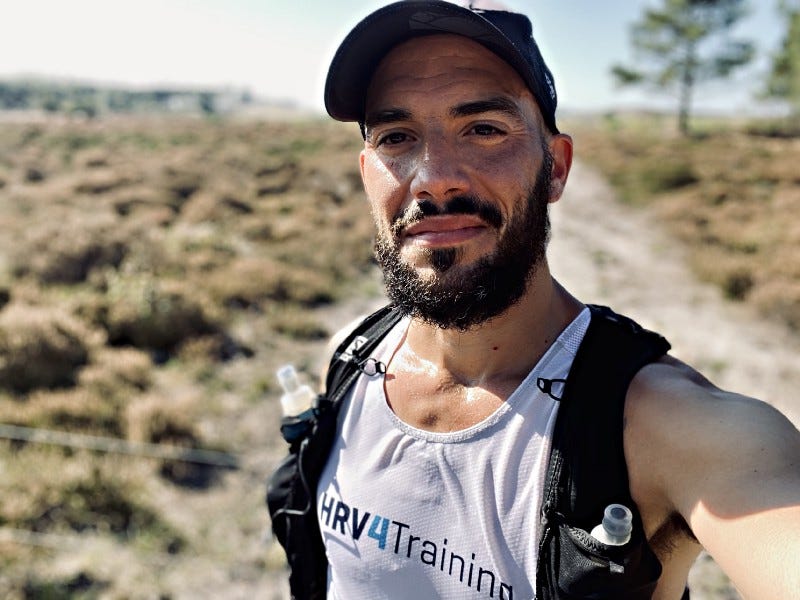
Marco holds a PhD cum laude in applied machine learning, a M.Sc. cum laude in computer science engineering, and a M.Sc. cum laude in human movement sciences and high-performance coaching.
He has published more than 50 papers and patents at the intersection between physiology, health, technology, and human performance.
Marco is the founder of HRV4Training, data science advisor at Oura, and guest lecturer at VU Amsterdam. He loves running.
Twitter: @altini_marco
how to find resting heart rate
Source: https://medium.com/@altini_marco/resting-heart-rate-and-heart-rate-variability-hrv-whats-the-difference-part-2-9a25607bb6c7
Posted by: tatummuccer.blogspot.com

0 Response to "how to find resting heart rate"
Post a Comment